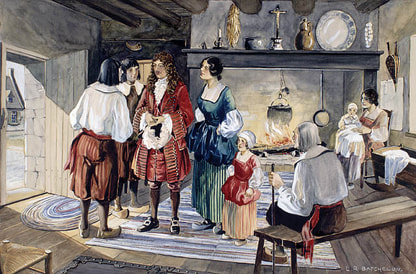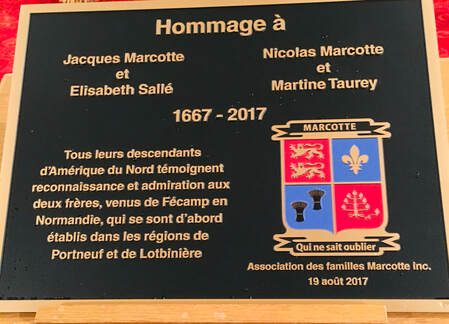
If you have French-Canadian ancestry, you most likely descend from one or more of a thousand “Mothers of New France’ – Filles à Marier and Filles du Roi. These incredible young women left a civilized, seventeenth-century France, endured a treacherous trans-Atlantic crossing with some dying while on route, and arrived malnourished and disoriented to a harsh wilderness manned by soldiers, fur trappers, and priests. They stayed with nuns to recuperate and be counseled on marriage and life ahead of them. They could be selective since the ratio of men to women was decidedly in their favor. The omnipresent Catholic Church was the only common denominator connecting these different worlds. Above is Sister Marguerite Bourgeoys leading arriving filles to the convent at Maison Saint-Gabriel

Les Filles à Marier, marriageable girls, arrived in Québec between 1634 and September 1663. These Mademoiselles arrived without the King’s auspices and traveled alone or with a few others in hopes of a new life. Why did they undertake this perilous journey? Was it on their volition? Did second thoughts ensue while on route or while enduring more severe winters than they had before? Did they long for a community of women like in the world they left? Pierre J. Gagné has written a brief biography of each of the 262 filles. Mon Fille à Marier is Marie Deligny, my eight-greats grandmother.
Marie was born about 1635 in the diocese of Meaux in the Brie region of Champagne. After her father’s death, she left for New France and eventually married Louis Jobidon in Québec City in the home of Guillaume Thibaut. No written marriage contract has been found possibly since neither spouse could sign their name. Marie and Louis had eleven children over a period of twenty years. Several were born in primitive quarters during the harsh Québec winters, three died young, and one was mentally challenged. Louis died in Château-Richer in 1677, a year after the baptism of his eleventh child. Marie raised the children as a widow until she married Julien Allard. He had been widowed years earlier and left for New France in 1665 alone. He and Marie had no children. Marie died 24 December 1696 and was buried at Château-Richer.
Marie was born about 1635 in the diocese of Meaux in the Brie region of Champagne. After her father’s death, she left for New France and eventually married Louis Jobidon in Québec City in the home of Guillaume Thibaut. No written marriage contract has been found possibly since neither spouse could sign their name. Marie and Louis had eleven children over a period of twenty years. Several were born in primitive quarters during the harsh Québec winters, three died young, and one was mentally challenged. Louis died in Château-Richer in 1677, a year after the baptism of his eleventh child. Marie raised the children as a widow until she married Julien Allard. He had been widowed years earlier and left for New France in 1665 alone. He and Marie had no children. Marie died 24 December 1696 and was buried at Château-Richer.

The Filles à Marier represent more than a quarter of the thousand or so female settlers to New France over a twenty-year period. Still, the growth of France’s new world outpost paled in comparison to New England’s, which had over twenty thousand settlers arrive there primarily in family groups between 1629 and 1640. King Louis XIV was at risk of losing his claim on the new world to his arch-enemy England. On advice from the Intendant of New France, Jean Talon (shown below), King Louis instituted a program to encourage women to leave for New France, marry, and bear children. Women primarily ages twelve to twenty-five and with a reference letter from their parish priest petitioned to become a King’s daughter, a Fille du Roi. Once accepted, King Louis paid on each daughter’s behalf a hundred livres to the French East India Company for her crossing and trousseau and a dowry of four hundred livres to encourage males to marry. As time went on, the dowry lessened and often was paid in kind. His daughters were held to a high moral standard and had to be physically fit to survive the crossing, the rigorous work that would ensue, and of course, child birthing.
The majority of the filles came from Paris, Normandy, and the western regions of France. Their social backgrounds differed, yet all were poor. Many were orphans with low literacy levels. Some came from noble families that had lost their fortunes, and others from large families with a daughter to ‘spare’. The filles disembarked at Québec City, Trois-Rivières, and Montreal. Most often the couples were engaged in a church with their priests as their witnesses. A marriage contract was signed and notarized to protect the women giving them financial security if anything happened to them or their husbands and the freedom to annul the contract should the husband prove incompatible. Some eight hundred filles arrived from 1663 to 1673, and Pierre J. Gagné has written a brief biography of each. Mon Fille du Roi is Élisabeth Salé, my seven-greats grandmother.
The majority of the filles came from Paris, Normandy, and the western regions of France. Their social backgrounds differed, yet all were poor. Many were orphans with low literacy levels. Some came from noble families that had lost their fortunes, and others from large families with a daughter to ‘spare’. The filles disembarked at Québec City, Trois-Rivières, and Montreal. Most often the couples were engaged in a church with their priests as their witnesses. A marriage contract was signed and notarized to protect the women giving them financial security if anything happened to them or their husbands and the freedom to annul the contract should the husband prove incompatible. Some eight hundred filles arrived from 1663 to 1673, and Pierre J. Gagné has written a brief biography of each. Mon Fille du Roi is Élisabeth Salé, my seven-greats grandmother.

Élisabeth was born about 1651 in Saint-Médard parish, Paris. Her father was a merchant-ironmonger to the palace. She arrived at Trois-Rivières at age nineteen with an estimated dowry of two hundred livres and married Jacques Marcot on 9 September 1670. Jacques signed the marriage contract and Élisabeth made a large É to acknowledge her King’s gift of a hundred livres. Jacques had been baptized 7 October 1644 in the parish of Saint-Léger, Fècamp, Normandy. He had arrived in New France along with his brother Nicolas in 1667. Nicolas had married the Fille à Marier Martine Taurey earlier.
Jacques and Élisabeth resided first at Trois-Rivières where their first two sons were baptized before settling at Neuville/Les Écureuils. Later, the family moved to Cap-Santé and settled on lot hundred and five of the new division. They would have fourteen children with many reaching adulthood. They had done their small part for their king, populate New France. Jacques died about 1718. Élisabeth died on 31 December 1722 and was buried at Cap-Santé
Jacques and Élisabeth resided first at Trois-Rivières where their first two sons were baptized before settling at Neuville/Les Écureuils. Later, the family moved to Cap-Santé and settled on lot hundred and five of the new division. They would have fourteen children with many reaching adulthood. They had done their small part for their king, populate New France. Jacques died about 1718. Élisabeth died on 31 December 1722 and was buried at Cap-Santé

On 19 August 2017, the Association de Famille Marcotte celebrated the 350th anniversary of the Marcotte families in North America. Virtually every Marcotte in Canada and the United States descend from either Jacques or Nicolas and their remarkable spouses Fille du Roi Èlisabeth Salé and Fille à Marier Martine Taurey, respectively; and I am one of those descendants.
Sources for this blog were extracted in part from The American-French Genealogical Society www.afgs.org, The Association des familles Marcotte www.famillesmarcotte.com, and Denis Thieven's 17 February 2109 article "The Filles du Roi: How Historical Revisionists and Feminists Have Slandered My Ancestors" publish on www.eurocanadian.ca

 RSS Feed
RSS Feed
